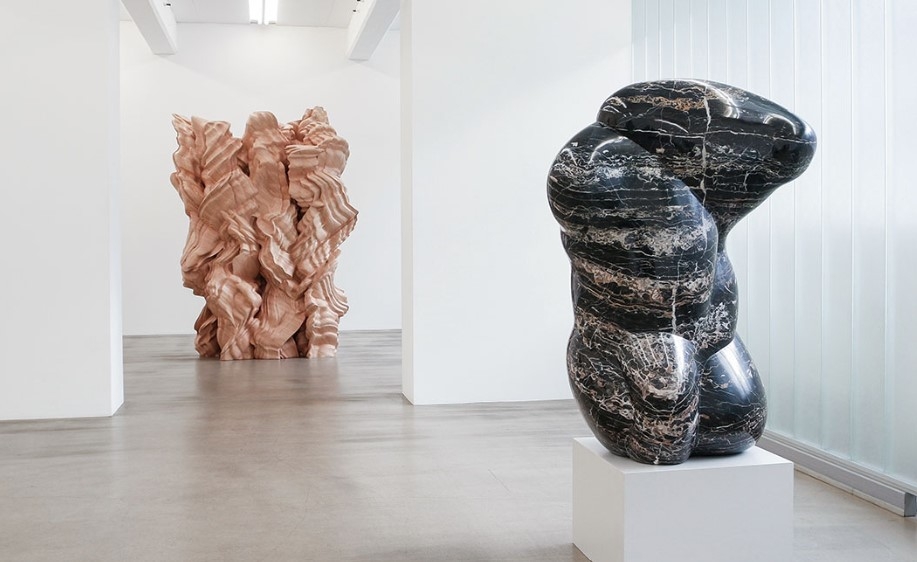GSA Gallery is proud to present its eighth solo exhibition with Tony Cragg, one of the world’s foremost sculptors. The works on display, created between 2018 and 2021, embody Cragg’s latest proposals for usage of materials, while – on a macro level – perpetually redefining relationships between humans and their surrounding material world. Generally, Cragg draws inspiration from both the natural, organic world, and from industrial systems, when developing his always recognizable sculptural shapes. Since the beginning of his career in the 1970s, the artist has been testing the possibilities of different materials, implicitly also pushing their boundaries. As such, his sculptures appear as a study of possibilities in the larger sense – of how materials and shapes are formed, demanding a reaction or invitation for reflection from the viewer. Such potential considerations are not limited by the artist but might include notions of consumerism or the throw-away society.

Photo from Galleri Andersson/Sandström
Cragg has previously stated: “Making sculpture involves not only changing the form and meaning of the material but also oneself.” A constant reassessment of the surrounding world, based on empirical observations, enables the artist to bring forward new, complex visual proposals, which use existing concepts as a point of departure (such as human or other organic shapes).
Cragg’s first retrospective in Denmark, Tony Cragg: Made on Earth, is currently open at the Herning Museum of Contemporary Art (HEART) and will remain on view until 22 August 2022. From July 2022, The Albertina Museum in Vienna will also turn an esteeming spotlight on Cragg’s oeuvre, with a solo exhibition bringing together both sculptures and drawings.
Cragg is universally regarded as one of today’s most important artists. He was born in Liverpool, UK in 1949 and has lived and worked in Wuppertal, Germany since 1977. He received a BA from Wimbledon School of Art, London, UK (1973) and an MA from the Royal College of Art, London, UK (1977).
A selection of most recent, major solo exhibitions includes Houghton Hall, UK (2021); Museum Belvédere, Netherlands (2021); Museu Oscar Niemeyer, Brazil (2020); Split Kula Cultural Institution, Croatia (2019); City of Arts and Sciences, Spain (2018); Isfahan Museum of Contemporary Art, Iran (2018); Istanbul Modern, Turkey (2017); Yorkshire Sculpture Park, UK (2017); the National Museum of Havana, Cuba (2017); MUDAM Luxembourg, Luxembourg (2017); Ludwig Museum, Koblenz, Germany (2017); amongst many others.
He is the recipient of numerous awards, including the Barnett Newman Foundation Award in 2016, the prestigious Praemium Imperiale Award in 2007, or the Turner Prize in 1988. He notably represented Britain at the 43rd Venice Biennale in 1988, while also being included in other collateral projects or museum shows during other Biennale editions. He was the first contemporary artist to exhibit under the pyramid of the Louvre Museum, Paris in 2011. In 2016, he was knighted by Queen Elizabeth II for his service to the visual arts and Anglo-German relations.
Another important contribution and notable lasting legacy is the Cragg Foundation, a not for profit initiative that enabled the Waldfrieden Sculpture Park in Wuppertal to open to the public in 2008. It houses a steadily growing collection of sculpture, including examples from Tony Cragg’s own large oeuvre. All is accompanied by changing exhibitions of internationally known artists, lectures on culture and the humanities, as well as concerts. Beyond this, the Cragg Foundation is also dedicated to research on, and the publication of, the subject of the fine arts.
Galerii nimi: Galleri Andersson/Sandström GSA Gallery
Address: Västra Strandgatan 9, 903 26 Umeå, Sweden
Phone: +46 (0)90 144990
Open by appointment
Open: 07.04.2022 — 14.05.2022
Address: Västra Strandgatan 9, 903 26 Umeå, Sweden
Phone: +46 (0)90 144990
Open by appointment
Open: 07.04.2022 — 14.05.2022